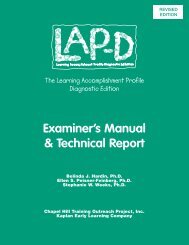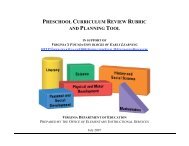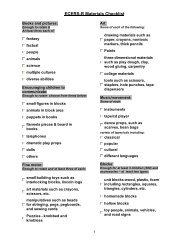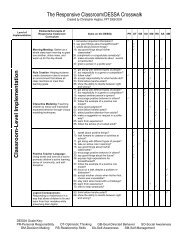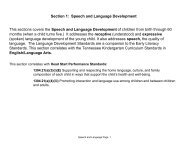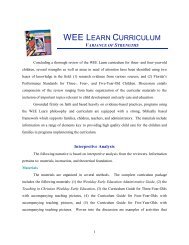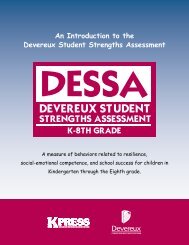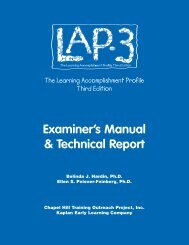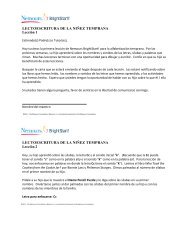DECA Manual - Kaplanco.com
DECA Manual - Kaplanco.com
DECA Manual - Kaplanco.com
You also want an ePaper? Increase the reach of your titles
YUMPU automatically turns print PDFs into web optimized ePapers that Google loves.
Thank you for your interest in Devereux’s Early Childhood Assessment (<strong>DECA</strong>) Program. Helping<br />
children be<strong>com</strong>e resilient leads to success in school and success in life. The <strong>DECA</strong> Program, a<br />
strength-based assessment and planning system, supports professionals and parents in promoting<br />
young children’s social and emotional wellbeing, thus promoting resilience. With a focus on primary<br />
prevention, the <strong>DECA</strong> Program is appropriate for all children ages 2-5 and should be used to build<br />
protective factors and prevent the development of behavioral concerns.<br />
<strong>DECA</strong> users value the Program’s strength-based orientation, strong family involvement <strong>com</strong>ponent,<br />
and user-friendly approach. Here is what some <strong>DECA</strong> Program users have to say about the program:<br />
“I became acquainted with the <strong>DECA</strong> when I was asked to review it for use in a local school<br />
district’s early childhood department. I was very impressed and gave it my endorsement.<br />
Rarely have I seen a tool that is dynamically based yet written in language that would be nonthreatening<br />
to educators and parents. The model of risk factors and protective factors puts<br />
teacher- child attachment in the limelight, just where it should be.” Lesley Koplow, Bank Street<br />
College, Author of Unsmiling Faces: How Preschoolers Can Heal<br />
“I must say that of all of the programs I have been exposed to, the <strong>DECA</strong> Program is the most<br />
exciting. I like the idea that it focuses on prevention and forms a working relationship between<br />
the parent and the teacher. Everyone I talk to in Cleveland who knows about this program<br />
says that it works and they just love it”. Constance Walker, Manager, Starting Point, Cleveland,<br />
Ohio<br />
“Most importantly I see that as we use the <strong>DECA</strong>, there is an attitudinal shift away from<br />
negative behaviors to positive behaviors. This shift means that many children who have the<br />
potential to be<strong>com</strong>e very challenging do very well over the course of their time in Head Start.”<br />
Deb Miller, Education Coordinator, Chester County Head Start, Coatesville, PA<br />
Research studies have confirmed a strong correlation between a child’s <strong>DECA</strong> scores and kindergarten<br />
readiness. Devereux is <strong>com</strong>mitted to supporting early childhood programs in using this standardized,<br />
valid and reliable tool in the classroom and home to create environments that promote strong<br />
protective factors, reduce behavioral concerns, and thus prepare children for success in school and<br />
life. For more information, visit www.devereux.org.<br />
The enclosed information packet provides an in-depth overview of the <strong>DECA</strong> Program as well as<br />
introduces new resources that support resilience in infants, toddlers and school-age children. If you<br />
have questions or are interested in learning more about any of our resources, please call toll free<br />
(866) TRAIN US or email deca@devereux.org.<br />
Sincerely,<br />
Linda K. Likins<br />
National Director<br />
Devereux Early Childhood Initiative
Table<br />
■<br />
of<br />
■<br />
Contents<br />
Understanding Resilience: The Foundation of the <strong>DECA</strong> Program............................1<br />
Introduction to the Devereux Early Childhood Assessment (<strong>DECA</strong>) Program...3<br />
The <strong>DECA</strong> Program Resources.....................................................................................................15<br />
Additional Devereux Early Childhood Initiative Resources........................................18<br />
Sample Pages from the <strong>DECA</strong> Program Classroom Strategies Guide....................19<br />
Development of the <strong>DECA</strong>............................................................................................................24<br />
Want to know more about the <strong>DECA</strong> Program?.................................................................31<br />
Contents of Pocket Folder<br />
• <strong>DECA</strong> Record Form and Individual Profile<br />
• For Now and Forever, A Guide for Families<br />
• Training Options Brochure<br />
• Head Start Out<strong>com</strong>es Brochure<br />
Table of Contents
Resilience<br />
Understanding■ Foundation the<br />
The■ ■<br />
of■ Program<br />
<strong>DECA</strong>■<br />
R<br />
esilience is defined as “the ability to recover from or adjust easily to misfortune or change.” 1<br />
Perhaps you know people who have achieved great success, despite growing up in poverty or without<br />
the support of a caring family. Something within these individuals allows them to “bounce back”<br />
from adversity. They can identify problems, determine ways to address them, recover quickly, and<br />
move on. Researchers who study resilience call these “somethings” protective factors. Protective factors<br />
are individual and environmental characteristics that are thought to reduce the risk of harm, support<br />
recovery, and foster social and emotional well-being.<br />
The primary goal of the <strong>DECA</strong> Program is to identify and build young children’s protective factors and<br />
thereby increase their resilience. A second goal is to support teachers, families, and <strong>com</strong>munities in<br />
their efforts to reduce the risk factors that hinder healthy social and emotional well-being.<br />
Researchers have found that protective factors can moderate or buffer the negative effects of stress for<br />
at-risk children. When at-risk children have well-developed protective factors, they are more likely to<br />
have positive lives. On the other hand, at-risk children whose protective factors are lacking or undeveloped,<br />
are more likely to experience emotional and behavioral problems. 2<br />
Resilience researchers have also identified risk factors—situations and characteristics that are thought<br />
to contribute to the probability that an individual will have great difficulty coping with life. For example,<br />
a child’s chronic illness or poor nutrition are risk factors; the same child’s easy temperament and<br />
engaging personality are protective factors. Temperament, personality, behavior, and other factors<br />
associated with an individual child are called “within-child” characteristics.<br />
1 Merriam-Webster’s collegiate dictionary (9th ed.). (1983). Springfield, MA: Merriam-Webster.<br />
2 Masten, A. & Garmezy, N. (1985). Risk, vulnerability and protective factors in developmental psychopathology. In Lahey, B. & Kazdin,<br />
A. (Eds.), Advances in Clinical Child Psychology (Vol. 8, pp. 1-52). New York: Plenum.<br />
1
Family and <strong>com</strong>munity protective and risk factors also affect a child’s resilience. For example, a supportive<br />
family is a protective factor; a family with a history of violence and abuse is a risk factor. A<br />
quality early childhood program is a protective factor; a <strong>com</strong>munity with few services for children and<br />
families is a risk factor.<br />
One of the first researchers to study resilience was Emmy E. Werner, a child psychologist at the<br />
University of California. Werner followed the development of a group of Hawaiian children from<br />
1955 to 1985. She found that about one-third of the children who were affected by four or more significant<br />
risk factors became successful adults. These children had several characteristics in <strong>com</strong>mon: 3<br />
■ They had been active and sociable infants.<br />
■ They had at least one positive role model who supported their development of trust, autonomy,<br />
and initiative.<br />
■ They had at least one skill that gave them a sense of pride and acceptance within their peer<br />
group.<br />
Werner’s study showed that the protective factors found in resilient children can serve as a shield<br />
against the negative effects of stress.<br />
3 Werner, E. (1982). Vulnerable but invincible: A longitudinal study of resilient children and youth. New York: McGraw Hill.<br />
2
Introduction to<br />
■<br />
the Devereux Early<br />
■<br />
Childhood Assessment<br />
■<br />
(<strong>DECA</strong>) Program<br />
■<br />
■<br />
T he <strong>DECA</strong> Program is a strength-based system designed to promote resilience in children ages 2-<br />
5. Through the program, early childhood professionals and families learn specific strategies to support<br />
young children’s social and emotional well-being and to enhance the overall quality of early childhood<br />
programs. The <strong>DECA</strong> Program focuses first on building quality environments through<br />
Universal interventions that promote positive behaviors in all children. For those children who are<br />
at-risk because of low protective factors, teachers learn to implement Targeted strategies in the classroom<br />
setting. For those children who need additional services at the Expanded level, the Clinical<br />
version of the assessment (<strong>DECA</strong>-C) is available –see page 18 for more information.<br />
3
4<br />
The centerpiece of the Devereux Early Childhood Assessment Program is the <strong>DECA</strong>, a standardized,<br />
norm-referenced behavior rating scale for children ages two to five. The <strong>DECA</strong> evaluates the frequency<br />
of 27 positive behaviors related to three protective factors: attachment, self-control, and initiative.<br />
The <strong>DECA</strong> also includes a 10-item Behavioral Concerns Screener which measures a variety of challenging<br />
behaviors seen in preschool children. The <strong>DECA</strong> is used within The <strong>DECA</strong> Program, a fivestep,<br />
strength-based system that begins before the <strong>DECA</strong> is administered and continues through interpretation<br />
of scores, planning, and evaluation. The following is an overview of the <strong>DECA</strong> Program.
<strong>DECA</strong> Program Underlying Principles<br />
Several important principles underlie the <strong>DECA</strong> Program. These principles are based on and<br />
developmentally appropriate practice as described by the National Association for the<br />
Education of Young Children (NAEYC). They are an integral part of any effective approach<br />
for promoting healthy social and emotional well-being. They are described below.<br />
1. The <strong>DECA</strong> Program is child-centered. The assessment, classroom strategies, family<br />
partnerships, and follow-up efforts respond to children’s individual characteristics and<br />
acknowledge the role of families and <strong>com</strong>munities in child development.<br />
2. The <strong>DECA</strong> Program is strength-based. The <strong>DECA</strong> identifies a child’s strengths related<br />
to within child protective factors. <strong>DECA</strong> results are used to set goals for each child.<br />
Teachers develop individualized plans for achieving the goals using strategies that build<br />
on the strengths of a child and family.<br />
3. The <strong>DECA</strong> Program encourages partnerships between teachers and families.<br />
Families and teachers each <strong>com</strong>plete the <strong>DECA</strong> for a child and jointly review the results.<br />
They collaborate to develop, implement, and evaluate individualized plans to address a<br />
child’s goals and support development at home and in the classroom.<br />
4. The <strong>DECA</strong> Program re<strong>com</strong>mends strategies that fit within an early childhood<br />
program’s current practices. The <strong>DECA</strong> and the suggested strategies are developmentally<br />
appropriate. Plans can be implemented in a child’s classroom and home as a<br />
part of established daily routines, activities, and experiences.<br />
5. The <strong>DECA</strong> Program supports effective collaborations. Families, teachers, and specialists<br />
share knowledge and work as a team to understand and address a child’s<br />
needs.<br />
6. The <strong>DECA</strong> Program stresses the importance of being data-driven early care<br />
and education professionals. Throughout the year, staff use multiple sources to collect<br />
data about their program practices and about each child’s skills, interests, needs,<br />
and other relevant characteristics. They use this information to <strong>com</strong>plete the <strong>DECA</strong> and<br />
to plan for individuals and the group.<br />
5
Step 1: Collect Information<br />
The first step in The <strong>DECA</strong> Program is to collect information about current program practices and<br />
about individual children. Teachers use multiple sources of information to <strong>com</strong>plete Reflective<br />
Checklists to assess program elements and to get to know each child in the class.<br />
1-A: Assess Program Elements<br />
Children’s behavior is affected by many factors, including the appropriateness of the early childhood<br />
program. Some program features support children’s development and encourage appropriate behavior.<br />
Others get in the way of a child’s progress and invite problem behaviors. For example, children<br />
are more likely to be active, engaged learners in a classroom filled with age-appropriate materials<br />
than they are in a classroom with materials that are either too simple or too challenging. While<br />
attempting to understand children’s activities and behaviors, teachers need to consider the effectiveness<br />
of all aspects of the program.<br />
To assist in the effort, the <strong>DECA</strong> Program uses five Reflective Checklists. The Reflective Checklists<br />
address:<br />
■ Environment (see sample page 7) ■ Supportive Interactions ■ Daily Program<br />
■ Activities and Experiences ■ Partnerships With Families<br />
Before administering the <strong>DECA</strong>, the teaching team can work together to use the Reflective Checklists<br />
to assess the status of their current practices related to fostering resilience.<br />
1-B: Get to Know Each Child<br />
In this substep, teachers spend at least four weeks getting to know each child, before they administer<br />
the <strong>DECA</strong>. To learn about the child’s health and developmental history, culture, family, home language,<br />
skills, needs, strengths, likes, dislikes, temperament, and preferred learning style they collect information<br />
from a number of sources.<br />
In addition, to gain first-hand knowledge of a child’s skills, needs, interests, and unique characteristics,<br />
teachers should work as a team to conduct a series of focused observations of each child in the<br />
class. It is not possible to get a <strong>com</strong>plete picture of a child in a single observation. Children’s behavior<br />
varies from day to day and can be affected by events at home and at the center. The series for<br />
each child should include observations conducted at different times of the day, in a variety of settings,<br />
and in a range of groupings from playing alone to taking part in a group meeting. The more times<br />
teachers observe, the more information they will collect about the child.<br />
(Sample Observation forms found in the Observation Journal)<br />
6
SAMPLE<br />
Reflective Checklist for the Environment<br />
Teacher(s):_________________________________<br />
Class<br />
Color—Green<br />
Date: ___________________________________<br />
1. Set up well-stocked interest areas that reflect children’s<br />
current skills and interests.<br />
2. Establish clear traffic paths and boundaries around interest areas.<br />
3. Display toys and materials on low, open shelves within<br />
children’s reach.<br />
4. Create a simple system to limit the number of children who can<br />
use an area at one time.<br />
5. Provide a few be-by-myself spaces that are private, but still visible<br />
to teachers.<br />
6. Provide storage areas (a shelf or cupboard) to keep and protect<br />
unfinished projects.<br />
7. Provide space to store and display individual work and belongings.<br />
8. Include in the classroom arrangement a large area for meetings,<br />
read-aloud sessions, and music and movement activities.<br />
9. Maintain a soothing and relaxing atmosphere with appropriate<br />
noise and activity levels.<br />
10. Create a home-like atmosphere that reflects children’s families,<br />
cultures, and home languages.<br />
11. Include a range of open-ended materials, from simple to <strong>com</strong>plex,<br />
that offer different levels of challenge.<br />
12. Include items that support children’s development of a sense of self.<br />
13. Provide materials that promote cooperation and group play.<br />
14. Offer materials that encourage children to explore and express<br />
their feelings.<br />
15. Provide materials that ac<strong>com</strong>modate a range of dramatic play skills.<br />
16. Provide materials, equipment, and space for indoor<br />
gross motor play.<br />
17. Offer duplicates of favorite items.<br />
18. Include supplies and equipment for personal care and clean-up.<br />
Yes<br />
Not Yet<br />
7
Step 2: Administer the <strong>DECA</strong><br />
Completed by both parents and teachers, the <strong>DECA</strong> is a strength-based assessment of protective factors<br />
in preschool children ages 2-5 which also contains a screener for behavioral concerns. The <strong>DECA</strong><br />
is standardized, norm-referenced, valid and reliable and has been shown to predict academic success<br />
in primary grades. The <strong>DECA</strong> includes:<br />
■<br />
■<br />
3 scales measuring attachment, self-control, and initiative<br />
A behavioral concerns scale<br />
The <strong>DECA</strong> was normed on a representative, nationwide sample of 2,000 children. It can be administered<br />
by both parents and teachers. A teacher can <strong>com</strong>plete a <strong>DECA</strong> Record Form for each child. A<br />
teacher must know the child for at least 4 weeks. The User’s Guide provides detailed information on<br />
administering and interpreting the <strong>DECA</strong> results. A <strong>DECA</strong> Record Form and Individual Child Profile<br />
are located in the pocket folder so that you have an opportunity to administer the <strong>DECA</strong>. It takes<br />
approximately 5-10 minutes to administer the <strong>DECA</strong> on each child.<br />
A web-based <strong>com</strong>puter scoring program is available. Please visit www.e-deca.org for more information.<br />
Step 3: Summarize <strong>DECA</strong> Results<br />
During Step 3: Summarize <strong>DECA</strong> Results, the parent and teacher ratings for the <strong>DECA</strong> are used to<br />
generate a <strong>DECA</strong> Individual Profile for each child. This essential form illustrates T-scores and<br />
Percentiles for the three Protective Factors Scales, the Total Protective Factors Scale, and the Behavioral<br />
Concerns Scale.<br />
Teachers also need to review the <strong>DECA</strong> ratings for the entire class. They summarize the <strong>DECA</strong><br />
Individual Profiles on a <strong>DECA</strong> Classroom Profile, an essential form that creates a visual summary of<br />
results for the entire class. It allows teachers to clearly see the number of children with specific<br />
strengths and needs. They can use this information to set priorities for planning and implementing<br />
changes in program practices. For example, if a teacher sees that more than half of the children have<br />
low scores in self-control, she can respond by reviewing practices related to self-control. A reproducible<br />
copy of the <strong>DECA</strong> Classroom Profile is included in the Observation Journal. A sample appears<br />
on the back cover of this booklet.<br />
8
<strong>DECA</strong> SAMPLE PROFILE<br />
■<br />
■<br />
■<br />
Lyn - a child with typical scores<br />
Protective factors are within the typical range<br />
Behavior concerns are also within the normal range<br />
9
<strong>DECA</strong> SAMPLE PROFILE<br />
■<br />
■<br />
Keisha - a child with social/emotional strengths<br />
Behavior concerns are typical and low<br />
10
<strong>DECA</strong> SAMPLE PROFILE<br />
■<br />
■<br />
James has concerns in all three protective factors<br />
Behavior concerns are typical<br />
11
<strong>DECA</strong> SAMPLE PROFILE<br />
■<br />
Amanda - a child whose ratings suggest concerns in<br />
all domains of the <strong>DECA</strong><br />
12
Step 4: Develop and Implement Strategies<br />
After <strong>com</strong>pleting the earlier steps in the system, teachers are ready to develop plans for supporting<br />
individual children as well as the entire class. They can use the Classroom Strategies Guide and other<br />
appropriate resources to choose strategies that can be tailored to respond to specific needs and<br />
strengths. The classroom profile mentioned earlier in step 3 is also helpful for planning purposes.<br />
As noted earlier on page 3, The <strong>DECA</strong> Program is a primary prevention program that is implemented<br />
at the universal and/or target levels. Teachers are encouraged to first implement universal strategies<br />
at the classroom level that are intended to benefit all children. Targeted strategies are also implemented<br />
by the teacher, but focus on specific children who obtain low scores on the within-child protective<br />
factors scales. By focusing first on the implementation of universal strategies that promote high<br />
quality settings and positive behaviors for all children, teachers then only develop targeted interventions<br />
for those children who do not respond to the Universal strategies.<br />
The Classroom Strategies Guide chapters 4-8 are specifically designed to provide teachers with planning<br />
strategies for both the class as a whole as well as for individual children. The five chapters each<br />
correspond with a reflective checklist. The <strong>DECA</strong> Program is built on the belief that when protective<br />
factors are increased, challenging behaviors are reduced. In order to provide an in-depth overview<br />
of how the Classroom Strategies Guide supports the planning process, several pages from Chapter 4,<br />
Using the Environment to Promote Resilience, are included in this booklet starting on page 17.<br />
Chapters 9 and 10 of the Classroom Strategies Guide address challenging behaviors.<br />
If a child continues to exhibit challenging behaviors, despite the interventions described above, the<br />
teacher and family might need to discuss making a referral to a mental health professional. Teachers<br />
should always have parental permission before making such a referral. The clinical version of the<br />
<strong>DECA</strong> (<strong>DECA</strong>-C) was developed for children showing significant behavioral concerns.<br />
Step 5: Evaluate Progress<br />
Much thought goes into the plans developed during the previous step. They reflect accurate, objective,<br />
<strong>com</strong>plete information about individual children and program elements and incorporate potentially<br />
successful strategies. Nevertheless, it is only after they have been implemented for a period of time<br />
that teachers and families can truly know whether the strategies have been effective. To assess the<br />
effectiveness of their plans, teachers <strong>com</strong>plete Step 5: Evaluate Progress. This step, which is ongoing<br />
rather than a fixed event, looks at both individual children and the program elements.<br />
This step, which is ongoing rather than a fixed event, encourages programs to evaluate progress on<br />
a continuous basis throughout the year. Several resources can be used to evaluate progress including:<br />
■ Reflective Checklists: Teachers are encouraged to continue using the Reflective Checklists to review<br />
effectiveness of each program element in supporting children’s resilience and preventing problem<br />
behaviors.<br />
■ The <strong>DECA</strong>: It is re<strong>com</strong>mended that teachers and families administer the <strong>DECA</strong> two to three times a<br />
year. As a standardized tool, pre-post assessment <strong>com</strong>parisons can be used to measure statistically<br />
significant improvements.<br />
13
■ Individual Plans: Teachers and families review the effectiveness of strategies used to help individual<br />
children build protective factors and/or change challenging behaviors.<br />
■ Staff and Family Satisfaction: Ongoing input from staff and families is critical, ensuring that all of<br />
the adults understand the importance of promoting children’s resilience and their important roles in<br />
the process.<br />
14
<strong>DECA</strong> Program Resources<br />
The <strong>DECA</strong> Program is implemented in an early childhood setting through effective use of the <strong>DECA</strong><br />
Program resources. Following is a brief summary of each of the <strong>DECA</strong> Program resources.<br />
ASSESSMENT<br />
■ <strong>DECA</strong> Assessment Record Forms & Scoring Profile<br />
The centerpiece of the <strong>DECA</strong> is a standardized, norm-referenced behavior rating scale that measures<br />
protective factors in preschool children. The starter kit includes 40 copies of the record form<br />
and scoring profile, so that both the child’s teacher and parent can <strong>com</strong>plete the assessment.<br />
Assessment results are then used to plan and set goals for individual children and the classroom as<br />
a whole in order to promote children’s social and emotional well-being. The assessment is available<br />
in both English and Spanish.<br />
■ e-<strong>DECA</strong><br />
The e-<strong>DECA</strong> is a web-based <strong>com</strong>puter program that administers the assessment online in either<br />
English or Spanish. The e-<strong>DECA</strong> <strong>com</strong>pletes all scoring, generates numeric and graphic summaries<br />
of results, and stores the results in a secure database. Avaliable reports include:<br />
■ Individual child profile<br />
■ Classroom profile<br />
■ Rater <strong>com</strong>parison (parent to parent, teacher to teacher, teacher to parent, and teacher to teacher)<br />
■ Pre- and post test <strong>com</strong>parisons to measure out<strong>com</strong>es<br />
■ Parent letter<br />
15
ASSESSMENT (continued)<br />
■ User’s Guide<br />
This manual provides all the information necessary to understand how to administer and score the<br />
<strong>DECA</strong>. Tables included in the manual explain how to score both pre- and post-test assessments and<br />
then determine if significant changes have occurred. Parent and teacher ratings may also be <strong>com</strong>pared<br />
to examine the difference between the school and home settings.<br />
■ Technical <strong>Manual</strong><br />
This manual provides information about the development of the assessment instrument. Included in<br />
the manual are the results of the reliability and validity studies that were conducted on the assessment<br />
instrument. The <strong>DECA</strong> meets or exceeds the standards set for a quality assessment tool. The<br />
information in the manual will provide individuals with confidence that they are using a welldeveloped<br />
instrument.<br />
FOR CLASSROOM PLANNING<br />
■ Classroom Strategies Guide<br />
The guide provides teachers with rich information about how to use the <strong>DECA</strong> results to plan and<br />
set goals to develop children’s protective factors and reduce behavioral concerns. The guide has 10<br />
chapters as described below:<br />
Chapters 1 through 3 provide an overview of Resilience and the Protective Factors that the Devereux<br />
Early Childhood Assessment Program is designed to strengthen, as well as an indepth-overview of<br />
the five step <strong>DECA</strong> Program assessment and planning process.<br />
Chapters 4 through 8 each focus on one program element (Environment, Daily Program, Activities<br />
and Experiences, Supportive Interactions, and Partnerships with Families). They re<strong>com</strong>mend classroom<br />
strategies for promoting resilience. For each strategy, there is an explanation of why the practice<br />
supports children’s development of protective factors and tips teachers can use to implement the<br />
strategy with the group and with individual children.<br />
Chapters 9-10 offer strategies for supporting individual children who need targeted assistance to<br />
build protective factors or address challenging behaviors.<br />
Three additional appendices provide additional information on:<br />
■ Setting the Stage so Infants and Toddlers can Begin to Develop Protective Factors<br />
■ Resources for Teachers<br />
■ Children’s Books that Support the Development of Resilience<br />
16
FOR CLASSROOM PLANNING (continued)<br />
■ Observation Journal<br />
This resource provides reproducible planning forms for programs that implement the <strong>DECA</strong><br />
Program. Four forms are considered essential in order to implement the <strong>DECA</strong> Program appropriately,<br />
the remainder of the planning forms are optional and are designed to help those programs<br />
that do not have planning forms in place. Two of the essential forms are found in the Observation<br />
Journal and may be reproduced (The <strong>DECA</strong> and the Individual Profile are the other two essential<br />
forms).<br />
FOR FAMILIES<br />
■ For Now and Forever: A Guide for Families<br />
This guide provides families with an introduction to social and emotional well-being as well as simple,<br />
specific home-based strategies that promote children’s resilience. The guide is an excellent tool<br />
around which parent education nights can be designed. The guide is available in both English and<br />
Spanish. (A copy is located in the pocket folder)<br />
Purchasing the <strong>DECA</strong> Program Resources<br />
The <strong>DECA</strong> Program “Blue Box” is designed as a kit for an early childhood classroom. In an<br />
ideal world, where early childhood programs have more than adequate funding levels, all<br />
classrooms would have their own <strong>DECA</strong> Program “Blue Box.” However, we understand that<br />
certain limitations may require more creative thinking in the way the <strong>DECA</strong> Program can be<br />
successfully implemented. Therefore, all the resources in the <strong>DECA</strong> Program Kit can also be<br />
purchased separately. We will be happy to work with your program to find the most costeffective<br />
strategy for implementing the <strong>DECA</strong> Program in your agency.<br />
Please contact the Devereux Early Childhood team at deca@devereux.org or call us at<br />
866-872-4687.<br />
17
Additional Devereux Early Childhood Initiative Resources<br />
Clinical version of the Devereux Early Childhood Assessment Clinical Form (<strong>DECA</strong>-C): is<br />
a standardized, norm referenced behavior-rating scale that assesses social/emotional strengths and<br />
concerns in preschool children and is intended for those select children already showing significant<br />
emotional/behavioral concerns. Measuring both a child’s strengths and behavioral concerns, the<br />
<strong>DECA</strong>-C provides a balanced description of the child’s behavior and allows for strength-based planning<br />
and strategy implementation. In keeping with the <strong>DECA</strong> Program’s emphasis on promoting<br />
strengths, the <strong>DECA</strong>-C includes three protective factors scales (Initiative, Self-control, and Attachment),<br />
in addition to four behavioral concerns scales (Attention Problems, Aggression,<br />
Withdrawal/Depression, Emotional Control Problems). Like the <strong>DECA</strong>, in best practice, the <strong>DECA</strong>-C<br />
is <strong>com</strong>pleted by both teachers and parents. However, the <strong>DECA</strong>-C must be interpreted by a behavioral<br />
healthcare or special education professional. For more information about this tool, please email<br />
deca@devereux.org or call toll free (866) TRAIN US.<br />
Devereux Early Childhood Assessment for Infants & Toddlers (<strong>DECA</strong>-IT) will be one of<br />
the first empirically derived strength-based measures of within-child protective factors for infants and<br />
toddlers. As with the <strong>DECA</strong>, the <strong>DECA</strong>-IT will be <strong>com</strong>pleted by family members and/or early care and<br />
education professionals. The <strong>DECA</strong>-IT will assess positive behaviors (i.e., strengths), identified as<br />
potential protective factors, exhibited by infants and toddlers. The tool will also be useful as a screener<br />
for potential risk factors associated with social and emotional development.<br />
The <strong>DECA</strong>-IT will be a program that seeks to understand and support the social and emotional wellbeing<br />
of infants and toddlers within the context of relationships and environmental supports, therefore,<br />
the <strong>DECA</strong>-IT will provide additional materials that will include: 1) tools that promote and enhance the<br />
quality of early care program elements such as supportive interactions, partnerships with parents and<br />
activities and experiences, 2) ideas and strategies for families to experience in the home environment<br />
and 3) reflective activities and tips for the promotion of adult resiliency skills and responsive caregiving.<br />
Devereux Elementary Student Strengths Assessment (DESSA): The DESSA will be a<br />
standardized, norm-referenced assessment of children’s individual strengths related to social and emotional<br />
well-being. The DESSA will be used as a prevention tool to identify children at-risk so that they<br />
can be supported before problem behaviors emerge. The DESSA will also be used to identify strengths<br />
for children with disabilities (as required by IDEA regulations) and monitor progress made by children.<br />
The <strong>DECA</strong>-IT is in the finalization period<br />
of the field study and should be in<br />
stock by Spring 2006. The DESSA<br />
Study is ongoing and should be available<br />
later in 2006.<br />
18
Sample Pages<br />
■<br />
<strong>DECA</strong> Program<br />
■<br />
from the<br />
■ ■<br />
Classroom<br />
■<br />
Strategies Guide<br />
■<br />
Chapter 4 (Pages 50-54):<br />
Using the Environment to Promote Resilience<br />
Introduction<br />
A<br />
n early childhood program environment includes the arrangement of the indoor and outdoor play<br />
areas, the materials children use, how materials are displayed and stored, and the people—teachers,<br />
family members, specialists, and others—whose actions help each child feel important and valued. A<br />
well-planned environment that promotes children’s resilience includes the following features:<br />
■ There are caring, skilled adults who build relationships with individual children.<br />
■ The room is free from health and safety hazards. Children are free to explore and experiment<br />
while teachers focus on supporting their development and learning.<br />
■ The room is large enough for the number of children enrolled (35 to 50 square feet of usable<br />
space per child). Children don’t feel cramped and don’t get in each other’s way.<br />
■ The space allows for flexible arrangements of equipment and furniture. It can be rearranged<br />
when necessary for different activities and routines.<br />
■ The space ac<strong>com</strong>modates the needs of the children enrolled, including children with disabilities.<br />
(For example, for a child who uses a wheelchair there is ample turning space, a table with raised<br />
legs, and a ramp leading outdoors.)<br />
■ The room is attractive and inviting. Furniture and equipment are in good repair and the floors<br />
and carpets are clean. There are soft and hard surfaces, soothing colors, and good lighting.<br />
Curtains hang in the windows, which are opened, as needed, to provide fresh air. Bulletin boards<br />
and displays are well-organized and the entire room is free of clutter.<br />
■ There are places where children can play alone and in groups of different sizes.<br />
19
■ Play items encourage children’s sense of security and offer appropriate challenges.<br />
They:<br />
—are sturdy, in good repair, free from splinters or peeling paint, and<br />
a safe size for the children enrolled;<br />
—reflect the ages, stages, cultures, and characteristics of the children enrolled;<br />
—encourage physical, cognitive, social, and emotional growth;<br />
—are open-ended (there is no right or wrong way to use them); and<br />
—are home-like to support children and to show families that their homes are filled with learning<br />
materials.<br />
Here are three examples to show how the environment promotes attachment,<br />
self-control, and initiative.<br />
Attachment<br />
Davida and Rhonda find<br />
a <strong>com</strong>fortable place to<br />
read and get to know<br />
each other.<br />
Davida and Rhonda (3 1 /2 years) are looking at the books on display<br />
in the library area. Each girl takes a book from the shelf. Rhonda<br />
says, “Lets look at books together.” Davida says, “Okay. We can sit<br />
over there.” The girls sit side by side in a pair of bean bag chairs.<br />
Davida holds her book in her lap so she and Rhonda can both see<br />
it. Davida turns the pages and both girls talk about the pictures. “My<br />
grandma has a quilt like that on her bed,” says Rhonda. “My<br />
grandma lives upstairs,” Davida responds.<br />
Self-Control<br />
Gina finds something<br />
to do while waiting<br />
for a turn at an easel.<br />
Gina (5 years) sees all of the easels are in use. She takes paper and<br />
crayons from the shelf and sits down to draw a picture.<br />
Occasionally, she glances at the children painting at the easels.<br />
When Danté takes off his smock, Gina says, “It’s my turn now. Can<br />
I please have your smock?” Danté hands her the smock. After<br />
putting away the paper and crayons, Gina puts on the smock and<br />
takes Danté’s place at the empty easel.<br />
Initiative<br />
Kirk uses a screen to<br />
block out distractions<br />
so he can stay focused<br />
on his task.<br />
Kirk (4 years) sorts some shells into several piles. Several times he<br />
looks up and scans the room to see what the other children are<br />
doing. Ms. Winn makes a suggestion, “Kirk, do you want to get the<br />
screen?” Kirk nods in agreement. He sets up a cardboard screen on<br />
the table and around the shells, then continues his sorting. Soon he<br />
invites Ms. Winn to see his work. “Look,” he says, “these ones are<br />
smooth and these have bumps on top.”<br />
20
Strategies for Using the Environment<br />
to Promote Resilience<br />
Strategy Page A SC I<br />
1. Set up well-stocked interest areas that reflect children’s current skills<br />
and interests.<br />
53<br />
✘<br />
✘<br />
2. Establish clear traffic paths and boundaries around interest areas.<br />
3. Display toys and materials on low, open shelves within children’s reach.<br />
53<br />
54<br />
✘<br />
✘<br />
✘<br />
✘<br />
✘<br />
4. Create a simple system to limit the number of children who can use<br />
an area at a time.<br />
54<br />
✘<br />
✘<br />
✘<br />
5. Provide a few be-by-myself spaces that are private, but still visible<br />
to teachers.<br />
55<br />
✘<br />
✘<br />
✘<br />
6. Provide storage areas (a shelf or cupboard) to keep and protect<br />
unfinished projects.<br />
55<br />
✘<br />
✘<br />
7. Provide space to store and display individual work and belongings.<br />
56<br />
✘<br />
✘<br />
8. Include in the classroom arrangement a large area for group events<br />
and music and movement activities.<br />
56<br />
✘<br />
✘<br />
✘<br />
9. Maintain a soothing and relaxing atmosphere with appropriate noise<br />
and activity levels.<br />
57<br />
✘<br />
✘<br />
10. Create a home-like atmosphere that reflects children’s families, cultures,<br />
and home languages.<br />
57<br />
✘<br />
✘<br />
✘<br />
11. Include a range of open-ended materials, from simple to <strong>com</strong>plex,<br />
that offer different levels of challenge.<br />
58<br />
✘<br />
✘<br />
12. Include items that support children’s development of a sense of self.<br />
13. Provide materials that promote cooperation and group play.<br />
58<br />
59<br />
✘<br />
✘<br />
✘<br />
✘<br />
✘<br />
✘<br />
14. Offer materials that encourage children to explore and express<br />
their feelings.<br />
59<br />
✘<br />
✘<br />
✘<br />
15. Provide materials that ac<strong>com</strong>modate a range of dramatic play skills.<br />
16. Provide materials, equipment, and space for indoor gross motor play.<br />
17. Offer duplicates of favorite items.<br />
18. Include supplies and equipment for personal care and clean-up.<br />
60<br />
60<br />
61<br />
61<br />
✘<br />
✘<br />
✘<br />
✘<br />
✘<br />
✘<br />
✘<br />
The charts that follow present strategies for using the environment to<br />
promote resilience, describe why each strategy supports children,<br />
and offer tips teachers can use to respond to the group and to individuals.<br />
21
1. Set up well-stocked interest areas that reflect children’s current skills<br />
and interests.<br />
Tips for Teachers<br />
Why<br />
Children can choose which interest<br />
area to explore and who to play<br />
with. SC, I<br />
Children can practice skills, take<br />
part in cooperative play, and learn<br />
to listen to and respect others.<br />
SC, I<br />
Children can explore special interests<br />
in depth. I<br />
For the Group<br />
Locate active areas such as<br />
dramatic play and blocks together<br />
and away from quiet areas<br />
such as reading.<br />
Consider how each area is used<br />
when setting up the room.<br />
Provide more space in areas<br />
used for group play such as dramatic<br />
play and blocks; and less<br />
in areas used by individuals or<br />
pairs such as <strong>com</strong>puters and<br />
reading.<br />
Keep some materials out all year<br />
to provide consistency. As children<br />
build skills and explore new<br />
interests, put out new items to<br />
provide fresh experiences and<br />
challenges.<br />
To Respond to<br />
Individuals<br />
Add items to an area to reflect a<br />
child’s special interest.<br />
Dion is fascinated with bugs so<br />
his teacher put a book on<br />
insects in the science area.<br />
Observe a child using an area.<br />
Rearrange it, remove unused items,<br />
and add new ones, as needed.<br />
Create a new area to respond to a<br />
child’s special interest.<br />
Ellie can’t stop talking about her<br />
family’s camping trips, so her<br />
teachers made a camping area.<br />
Stock areas with materials that<br />
ac<strong>com</strong>modate a range of skills and<br />
abilities so a child can choose<br />
items that match her skills and<br />
interests.<br />
2. Establish clear traffic paths and boundaries around interest areas.<br />
Tips for Teachers<br />
Why<br />
Children are less likely to run or<br />
get in each other’s way if traffic<br />
paths go around interest areas<br />
rather than from one end of the<br />
room to the other. SC<br />
Children are more likely to stay<br />
focused when not distracted by<br />
activities in other areas. I<br />
For the Group<br />
Use walls, low partitions, and<br />
low, open shelves to define interest<br />
areas and traffic paths.<br />
Indicate the entrances to interest<br />
areas by putting wide plastic<br />
tape or duct tape on the floor.<br />
To Respond to<br />
Individuals<br />
Create two ways to get in or out of<br />
active interest areas so a child can<br />
get out if he feels crowded.<br />
Tape two large pieces of cardboard<br />
together to make a folding<br />
screen. Set up the screen to help a<br />
child focus on her drawing or puzzle<br />
without being distracted by<br />
other children’s conversations and<br />
activities.<br />
22
3. Display toys and materials on low, open shelves within children’s reach.<br />
Tips for Teachers<br />
Why<br />
Children feel secure when they<br />
can find what they want to use. A<br />
Children are encouraged to be<br />
independent when they don’t need<br />
adult help to find what they need.<br />
I<br />
Children can help care for the<br />
room when they can see where<br />
things go. SC<br />
For the Group<br />
Use picture and word labels<br />
to show where things go.<br />
Store materials used together<br />
such as crayons and paper in<br />
the same place.<br />
Store small items such as strings<br />
and beads in open, labeled<br />
containers.<br />
Minimize clutter by putting away<br />
items children don’t use.<br />
To Respond to<br />
Individuals<br />
Participate at clean-up time to<br />
show a child how to figure out<br />
where things are stored. As you<br />
put an item away, show her the<br />
label. Point out the things that go<br />
together.<br />
“Jasmine, the pegs go in this<br />
basket, right next to the pegboards.<br />
Next time you want to<br />
use them, they will be easy to<br />
find.”<br />
4. Create a simple system to limit the number of children who can use an<br />
area at a time.<br />
Tips for Teachers<br />
Why<br />
Children gain a sense of security<br />
when they understand and have<br />
support to follow the limits. A, SC<br />
Children are less likely to get in<br />
each other’s way when they have<br />
enough room to work and play.<br />
They can carry out plans and stick<br />
with a task without being distracted.<br />
SC, I<br />
For the Group<br />
Limit the number of chairs in<br />
an area.<br />
There are four chairs at the<br />
table in the writing area and<br />
two at the <strong>com</strong>puter.<br />
Limit the equipment or materials.<br />
Six smocks hang by the easels<br />
and four pairs of safety goggles<br />
hang on the woodworking<br />
bench.<br />
Hang tags and an “In/Out”<br />
board at the entrance to an<br />
area. When all the tags are on<br />
the “In” side,<br />
the area is full.<br />
Use group time to discuss how<br />
the system is working. Ask:<br />
“Why do you think…?”<br />
“What could happen if…?”<br />
“How could it work better?”<br />
To Respond to<br />
Individuals<br />
Help a child understand how the<br />
system works.<br />
“Carly, there’s one more pair of<br />
safety goggles, so you can play<br />
at the woodworking table.”<br />
“Zack, both <strong>com</strong>puter chairs are<br />
in use. When one of the children<br />
finishes and leaves the<br />
area, you can use the <strong>com</strong>puter.”<br />
Help a child find something to do<br />
while waiting to use the area.<br />
“Kia, would you like to paint or<br />
toss bean bags?”<br />
Help a child express feelings of<br />
frustration when an area is full.<br />
“Stefan, I know it’s hard to wait.<br />
Do you want to talk about it?”<br />
23
Development<br />
■<br />
<strong>DECA</strong><br />
of<br />
■<br />
the<br />
The Devereux Early Childhood Assessment (<strong>DECA</strong>)<br />
A Measure of Within-Child Protective Factors<br />
in Preschool Children<br />
Paul A. LeBuffe & Jack A. Naglieri<br />
T<br />
he 1980s witnessed a burgeoning interest in the delineation and investigation of protective factors<br />
in children, which has persisted in the current decade. Protective factors are individual and environmental<br />
characteristics that are thought to moderate or buffer the negative effects of stress and result<br />
in more positive behavioral and psychological out<strong>com</strong>es in at-risk children than would have been possible<br />
in their absence (Masten & Garmezy, 1985). Children whose behavior reflects these protective<br />
factors tend to have positive out<strong>com</strong>es despite stress and are often characterized as “resilient.”<br />
Children lacking, or with underdeveloped protective factors, are more likely to develop emotional and<br />
behavioral problems under similar risk conditions and are described as “vulnerable.”<br />
Interventions premised on strengthening protective factors in young children have shown promise in<br />
reducing the occurrence of severe emotional and behavioral disorders and other negative life out<strong>com</strong>es.<br />
Typical interventions include providing preschoolers with the opportunity to establish relationships<br />
with supportive caring adults who serve as positive role models or mentors, developing parent<br />
training programs that offer family-centered support and strategies to promote resilience, and teaching<br />
caregivers how to encourage the development of independence, self-esteem and self-efficacy in<br />
preschoolers.<br />
Garmezy (1985) suggested that protective factors could be divided into three categories: 1) dispositional<br />
attributes of the child, 2) supportive family environment, and 3) external support systems.<br />
Although reliable measures of Garmezy’s second and third categories exist, to date no empirically<br />
sound and widely available measure of child behaviors related to resiliency (i.e. “within-child” protective<br />
factors) has been developed.<br />
In addition to hindering program development, refinement and evaluation, the lack of such an instrument<br />
has also made it difficult to reliably identify individual children who may have low protective factors<br />
and are therefore at increased risk of developing emotional and behavioral problems. Identifying<br />
24
these children is particularly important in that they might benefit most from resilience enhancing interventions.<br />
This report reviews the development, standardization, validation and use of a new, nationally standardized<br />
measure of within-child protective factors, the Devereux Early Childhood Assessment, that<br />
has been developed as part of a national initiative, sponsored by the Devereux Foundation, to foster<br />
the healthy emotional growth of preschool children.<br />
The Devereux Early Childhood Assessment<br />
Developed over a two year period in 1996-98, the Devereux Early Childhood Assessment or <strong>DECA</strong><br />
is a nationally normed assessment of within-child protective factors in preschool children aged two to<br />
five. Completed by parents, family caregivers or early childhood professionals (preschool teachers<br />
and child care providers), the <strong>DECA</strong> evaluates the frequency of 27 positive behaviors (i.e. strengths)<br />
exhibited by preschoolers. Typical items include “chooses to do task that are challenging for him/her,”<br />
“shows patience,” and “ask adults to play with or read to her/him.” These items were derived from<br />
the childhood resilience literature and through focus groups conducted with parents and early childhood<br />
professionals. The <strong>DECA</strong> also contains a 10-item behavioral concerns screener.<br />
The three primary purposes of the <strong>DECA</strong> are: 1) to identify children who are low on the protective factors<br />
so that targeted classroom and home-based strategies can be implemented leading to the<br />
strengthening of these abilities, 2) to generate classroom profiles indicating the relative strengths of all<br />
children so that classroom design and instructional strategies can build upon these strengths to facilitate<br />
the healthy social and emotional growth of all children, and 3) to screen for children who may<br />
be exhibiting behavioral concerns so that these can be addressed before they be<strong>com</strong>e entrenched and<br />
possibly develop into behavioral disorders.<br />
Standardization Sample - The <strong>DECA</strong> was standardized on a sample of 2,000 preschool children who<br />
resided in 28 states. Half of the children in the sample were rated by a parent or other family caregiver;<br />
and half by a preschool teacher or child care center staff. Similarly, 51% of the children rated<br />
were boys and 49% girls. One quarter of the children in the sample were from poor families (defined<br />
as either receiving public assistance or subsidized child care) which matches the prevalence of poverty<br />
among young children. The sample was stratified on race, Hispanic ethnicity, and region of residence.<br />
The most recent data available from the United States Department of the Census was used to<br />
identify appropriate percentages for these variables. As indicated in Table 1 (race), Table 2 (Hispanic<br />
ethnicity) and Table 3 (Region of Residence) the <strong>DECA</strong> Standardization Sample very closely approximates<br />
the preschool population of the United States. These results indicate that the <strong>DECA</strong> was normed<br />
on a sample of children that accurately reflects the diversity of preschool children in the country.<br />
Scale Development - Exploratory factor analysis of the standardization items yielded a <strong>com</strong>prehensible<br />
series of scales that were consistent with published descriptive longitudinal research on protective<br />
factors (e.g., Werner and Smith, 1982). A three-factor solution fit the data best. Based on an inspection<br />
of the item content of the three factors, the scales were labeled:<br />
25
Initiative - which measures the child’s ability to use independent thought and action to meet his or<br />
her needs.<br />
Self Control - which assesses the child’s ability to experience a range of feelings and express them<br />
using the words and actions that society considers appropriate.<br />
Attachment - a measure of a mutual, strong, and long-lasting relationship between a child and significant<br />
adult(s).<br />
Reliability of the <strong>DECA</strong> - As shown in Table 4, the <strong>DECA</strong> is a highly reliable instrument. Each of the<br />
alpha coefficients for the protective factor scales meets or exceeds the .80 “desirable standard” established<br />
by Bracken (1987) for internal consistency estimates. The alpha coefficent for the Behavioral<br />
Concerns Scale is lower, reflecting the heterogeneity of this scale.<br />
Test-Retest reliabilities over a 24-hour period were calculated for both parents and teachers. The reliabilities<br />
for the protective factors ranged from .55 to .80 for parents and .87 to .94 for teachers. All<br />
of these correlations were significant at the .01 level.<br />
Interrater reliability of the <strong>DECA</strong> was established by <strong>com</strong>paring ratings provided by teachers and<br />
teachers aides. The reliabilities for the protective factors ranged from .59 to .77. Again, all correlations<br />
were significant at the .01 level.<br />
Validity - The criterion validity of the <strong>DECA</strong> was established by examining its ability to correctly predict<br />
whether an individual child was part of a clinical (n = 95) or a matched non-referred (n = 86)<br />
sample. Any child who had been given a psychiatric diagnosis, was being seen by a mental health<br />
professional for emotional or behavioral problems, had been asked to leave a child care program due<br />
to his/her behavior, or had an individualized behavior management plan in place was considered to<br />
be part of the clinical sample. If none of these conditions were true, the child became part of the nonreferred<br />
sample.<br />
Using the interpretive guidelines suggested in the <strong>DECA</strong> manual, the Total Protective Factors score was<br />
able to correctly classify 69% of the children in this study. This figure <strong>com</strong>pares favorably with the classification<br />
accuracy of well-established scales of symptomatic behavior such as the Devereux Scales of<br />
Mental Disorders (Naglieri, LeBuffe & Pfeiffer, 1995).<br />
Construct validity was explored by correlating scores on the protective factor scales and the Behavioral<br />
Concerns scale. An overall correlation of -.65 was obtained indicating that protective factors and<br />
problem behaviors are inversely related.<br />
Additional validity and reliability data are presented in the <strong>DECA</strong> Technical <strong>Manual</strong>.<br />
Implications and Importance<br />
Since the seminal studies of Emily Werner, professionals have recognized that protective factors in<br />
early childhood have a crucial role in determining subsequent adjustment or maladjustment to life<br />
stresses. Werner’s re<strong>com</strong>mendation that both assessment and diagnosis in early intervention should<br />
focus on protective factors as well as risks (Werner, 1990) has been hampered by the lack of an eco-<br />
26
nomical, psychometrically sound, and clinically useful measure of within-child protective factors. The<br />
<strong>DECA</strong> has been developed to fill this gap and thereby provide early childhood professionals with an<br />
empirically sound tool for assessing the strength of protective factors in preschoolers.<br />
Based on the belief that the primary value of assessment is to guide effective services for children, the<br />
<strong>DECA</strong> has been developed as part of a <strong>com</strong>prehensive program to foster the healthy social and emotional<br />
development of children.<br />
27
References<br />
Bracken, B. A. (1987). Limitations of preschool instruments and standards for minimal levels of<br />
technical adequacy. Journal of Psychoeducational Assessment, 5, 313-326.<br />
Garmezy , N. (1985). Stress-resistant children: the search for protective factors. In J. E.<br />
Stevenson (Ed.). Recent research in developmental psychopathology. Journal of Child Psychology<br />
and Psychiatry (Book Supplement, Number 4, pp.213-233). Oxford: Pergamon Press.<br />
Masten, A. S., & Garmezy, N. (1985). Risk, vulnerability and protective factors in developmental<br />
psychopathology. In B. B. Lahey & A. E. Kazdin (Eds.), Advances in clinical child psychology (Vol.<br />
8, pp. 1-512). New York: Plenum.<br />
Naglieri, J. A., LeBuffe, P. A., & Pfeiffer, S. I. (1995). The Devereux Scales of Mental Disorders.<br />
San Antonio, TX: The Psychological Corporation.<br />
Werner, E. E., & Smith, R. S. (1982). Vulnerable but invincible: A study of resilient children. New<br />
York: McGraw-Hill<br />
28
Table 1<br />
Standardization Sample: Race<br />
* U.S. Bureau of the Census does not collect these data.<br />
Note: The U.S. population data are based on “Resident Population, by Race, Hispanic Origin, and<br />
Single Years of Age: 1995, Table No. 22,” Statistical Abstract of the United States: 1996 The National<br />
Data Book by the U.S. Bureau of the Census 1996. Washington, D.C.: Author.<br />
Table 2<br />
Standardization Sample: Hispanic Origin<br />
* Numbers based on the entire population of each region.<br />
Note. The U.S. population data are based on “Resident Population, by Race, Hispanic Origin, and<br />
Single Years of Age: 1995, Table No. 22,” Statistical Abstract of the United States: 1996 The National<br />
Data Book by the U.S. Bureau of the Census 1996. Washington, D.C.: Author.<br />
29
Table 3<br />
Standardization Sample: Region<br />
Note. The U.S. population data are based on “Resident Population, by Age and State:1995, Table<br />
No. 34,” Statistical Abstract of the United States: 1996 The National Data Book by the U.S. Bureau<br />
of the Census 1996. Washington, D.C.: Author.<br />
Table 4<br />
<strong>DECA</strong> Reliability<br />
30
Want to know more about the <strong>DECA</strong> Program?<br />
The Devereux Early Childhood Assessment (<strong>DECA</strong>) Program is being implemented in early childhood<br />
settings across the nation. To learn more about how the <strong>DECA</strong> Program is being used to successfully<br />
promote the quality of classrooms and promote children’s protective factors, please visit our<br />
website at: www.devereuxearlychildhood.org<br />
For more information on:<br />
■ How the <strong>DECA</strong> Program meets Head Start Performance Standards<br />
■ How the <strong>DECA</strong> Program meets National Association for the Education of Young Children guide<br />
lines<br />
■ Research Projects<br />
■ Success Stories<br />
■ Up<strong>com</strong>ing Calendar of Presentations and Trainings<br />
■ Additional Assessment and Planning Tools including <strong>DECA</strong>-C, <strong>DECA</strong>-IT, and DESSA.<br />
<strong>DECA</strong> Program Training Options<br />
<strong>DECA</strong> Program implementation training is delivered at locations across the nation several times<br />
throughout the year and can also be delivered at your site. Several training options are available<br />
and all trainings are conducted by Devereux Certified Trainers. To learn more about the various<br />
training options, including locations, scheduling and costs, please contact the Devereux Early<br />
Childhood Initiative at 866-872-4687.<br />
For more information on the <strong>DECA</strong> Program contact us at:<br />
The Devereux Foundation<br />
444 Devereux Drive<br />
Villanova, PA 19085<br />
Phone: 610-542-3109<br />
e-mail: <strong>DECA</strong>@Devereux.org<br />
www.devereuxearlychildhood.org<br />
To order the <strong>DECA</strong> Program, contact Kaplan Early Learning Company at:<br />
Phone: (800) 334-2014 or order online at www.kaplanco.<strong>com</strong>.<br />
31
Teachers’ Names: Mr. Welch<br />
<strong>DECA</strong> Classroom Profile<br />
1 st <strong>DECA</strong> Administration 2 nd <strong>DECA</strong> Administration 3 rd <strong>DECA</strong> Administration<br />
Date: 3/15/00 Date: Date:<br />
NAME ID I SC A BC I SC A BC I SC A BC<br />
Maria<br />
Jerome<br />
Tamika<br />
Eddie<br />
Lin<br />
Jessica<br />
Santiago<br />
Gina<br />
Kit<br />
Shanise<br />
Rhonda<br />
Drew<br />
Ann<br />
Deandre<br />
Kia<br />
Sam<br />
Callie<br />
Thomas<br />
Total Number of Children in Classroom 18 18 18 18<br />
Number of children red (concern) 2 5 3 1<br />
Number of children blue (typical) 11 10 10<br />
Number of children green (strength) 5 3 5<br />
SCALE LEGEND COLOR CODING LEGEND<br />
A – attachment RED – protective factor scores 40 and below & behavioral concerns 60 and above<br />
SC – self-control BLUE – protective factor scores between 41 – 59 inclusive<br />
I – initiative GREEN – protective factor scores 60 and above<br />
*BC – behavioral concerns - * only code scores 60 and above<br />
Copyright © 2001, Devereux Early Childhood Initiative. All rights reserved by The Devereux Foundation.



